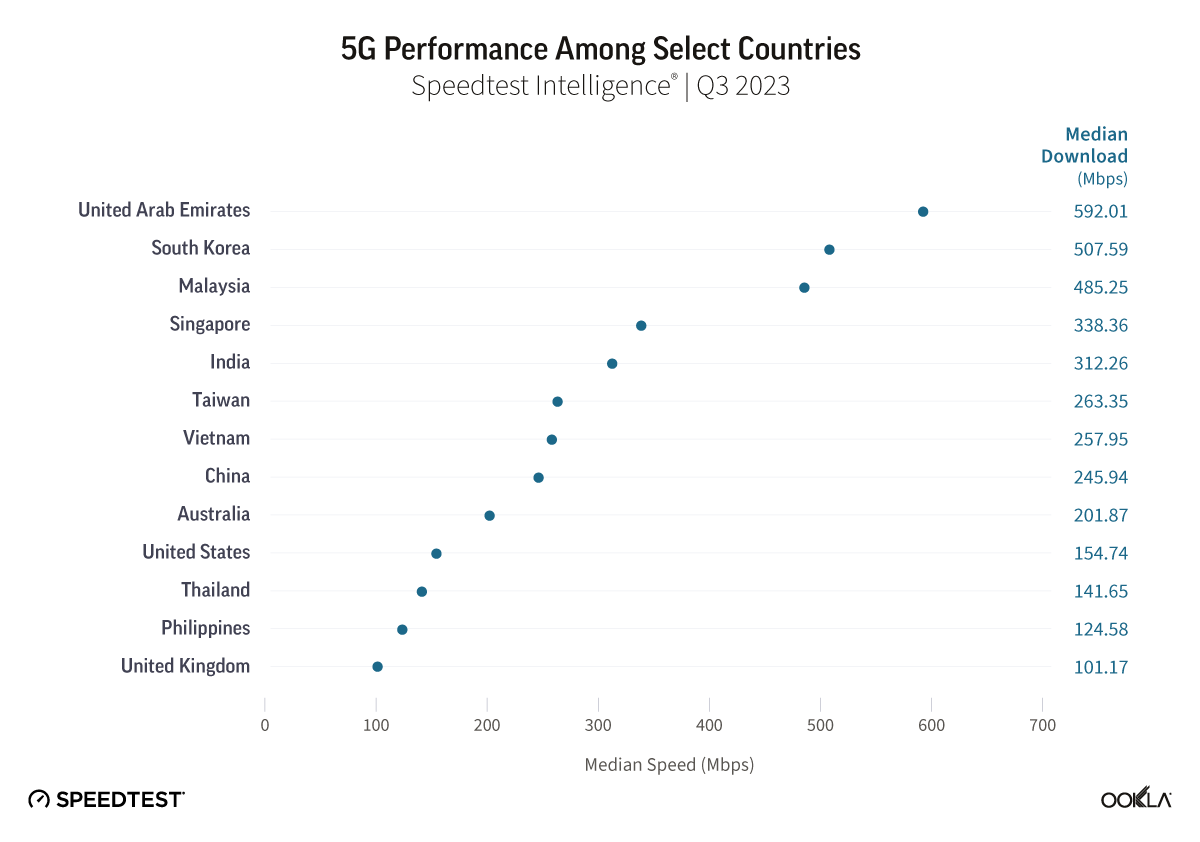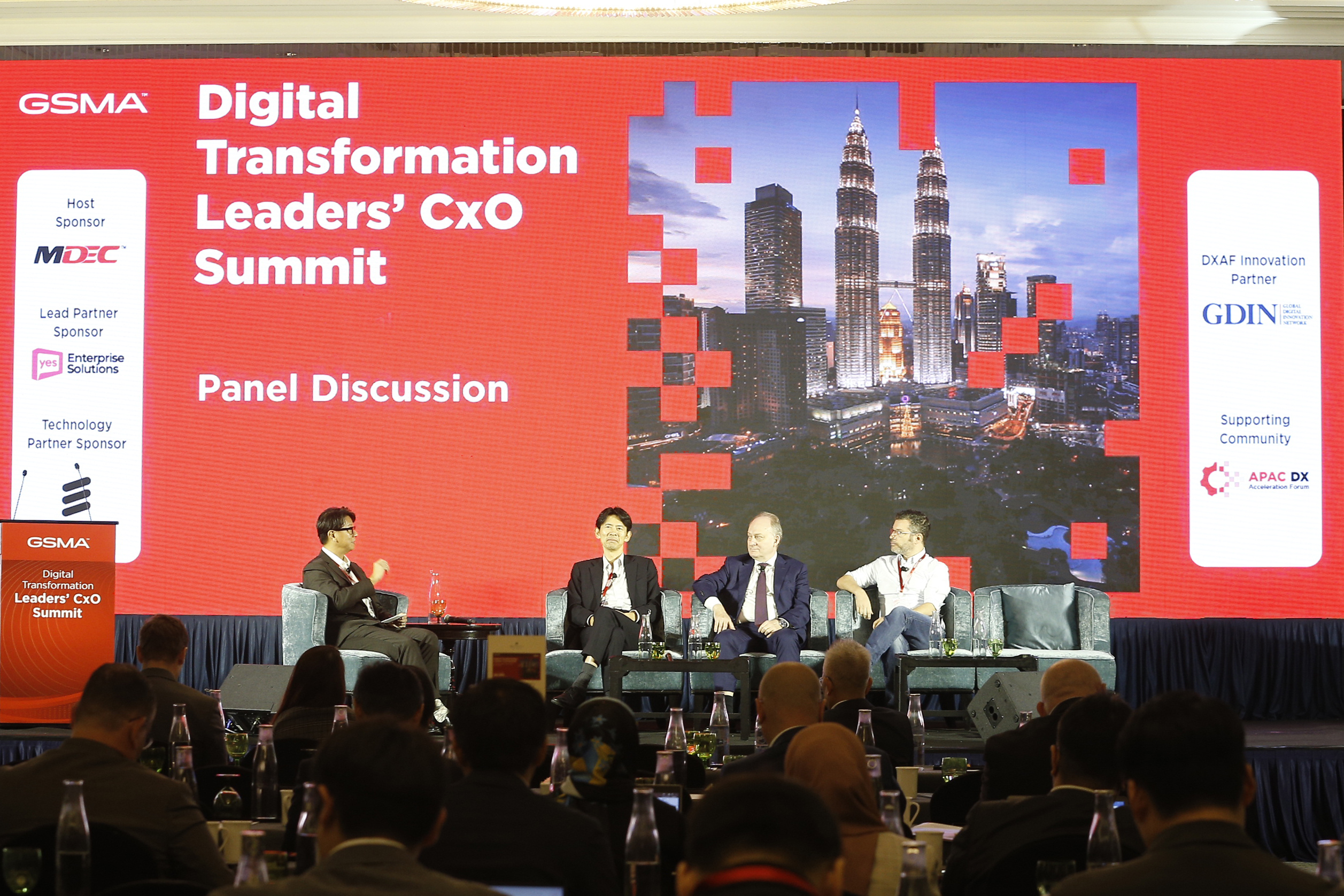Ookla® recently participated in the Digital Transformation Leaders’ CxO Summit in Kuala Lumpur, Malaysia, on November 22nd and 23rd, 2023. At the summit, leaders from multiple mobile network operators, governments, industries, and ecosystem players gathered to discuss commercial strategies, technological advancements, and industry promotion policies. The aim was to accelerate sector-wide intelligent digital transformation in the 5G era by addressing opportunities and challenges.
Key Takeaways
- Adopting digital transformation is crucial to compete in the 5G era. Digital transformation is essential for industry players to stay competitive in the digital age. Despite challenges, the potential benefits, like better efficiency, improved customer experiences, and innovation opportunities, make it crucial for industries to undertake.
- A collaborative effort is necessary for Open RAN’s success. Despite the global momentum of Open RAN, challenges stemming from interoperability issues among hardware and software stacks pose significant hurdles, demanding a collaborative effort within the telecom industry to ensure the success of this transformative technology.
- Complementing terrestrial networks with Non-Terrestrial Networks (NTN) is crucial for global connectivity. Combining both networks’ strengths creates a more robust communication infrastructure that enhances connectivity, reliability, and coverage.
5G is an integral element of any country’s digital transformation strategy
Mobile connectivity stands as a driving force for digital innovation and economic growth across the Asia Pacific region. GSMA reports that mobile technologies and services contributed nearly 5% of the region’s GDP in 2022, translating to a substantial $810 billion in economic value added. This underscores the pivotal role of 5G deployment in fostering economic growth, benefiting both individuals and enterprises. As the backbone of transformative technologies, 5G has become a catalyst for innovation, propelling the Asia Pacific region into the forefront of the global digital economy.
During his opening speech, Julian Gorman, the Head of APAC for GSMA, highlighted that the Asia Pacific region is a collection of diverse markets, each at a unique stage of growth regarding 5G adoption. Countries in the region are charting their own individual paths in deploying 5G networks. The tailored approach is essential as it accommodates varying technological landscapes, economic conditions, and regulatory frameworks and allows nations to capitalize on 5G’s potential in a manner that aligns with their specific needs and challenges.
Several speakers quoted Ookla’s recent report highlighting how the Asia Pacific region has some of the world’s fastest 5G networks, with South Korea and Malaysia ranking in the top three countries for 5G network speeds globally. Malaysia has achieved impressive 5G performance, ranking third globally for 5G download speed with a reported speed of 485.25 Mbps, surpassing its Southeast Asian neighbors. This is despite launching its nationwide 5G network less than two years ago and adopting an unconventional deployment strategy.
Co-CEO of DNB, Datuk Ahmad Zaki Bin Zahid, emphasized during his speech that the journey towards 5G adoption goes beyond just speed and that a strong network infrastructure foundation is crucial. His remarks underscore the need for a strategic and thoughtful planning approach when building a solid network foundation for new 5G applications. Investing strategically in building and expanding telecommunications networks is crucial for unlocking the nation’s digital transformation and driving growth. Earlier this year, the Malaysian government announced its intention to transition to a dual network model once the current rollout under DNB has achieved 80% coverage of populated areas. How implementing a dual network will impact Malaysia’s 5G adoption and digital transformation remains to be seen.
Embracing network digital transformation is necessary for staying competitive in the 5G era
During the session titled “Network Digital Transformation in the 5G Era,” industry experts emphasized the significance of network digital transformation in the 5G era. The speakers’ discussed how 5G technology has revolutionized the way networks operate and how it supports digital transformation for businesses. In his presentation, Ericsson’s Asia-Pacific Group CTO, Magnus Everbring, explained how a well-built 5G network and through enhanced features such as network slicing, or 5G Standalone, will be able to differentiate traffic for new services, thus utilizing the 5G network to its full potential. This will open up possibilities for new 5G services for enterprises and consumers, moving beyond broadband use cases and into various industry verticals such as healthcare, utilities, manufacturing, media and broadcast, and the public sector.
Overcoming interoperability hurdles for Open RAN
Open RAN has recently been gaining traction globally. However, several single vendor operators often face technical and verification challenges in implementing Open RAN. According to our recent report that analyzed telco trends for 2024, industry experts believe that interoperability issues across hardware and software stacks are hindering Open RAN’s progress, causing delays in its implementation timelines. Resolving these challenges is crucial to the success of Open RAN and will require a concerted effort from the telecom industry.
In a panel discussion, Dr. Sadayuki Abeta, the Global Head of Open RAN at NTT DOCOMO, discussed how the company is using its expertise to support the Open RAN efforts of operators worldwide. NTT DOCOMO has introduced its Open RAN OREX platform, designed to simplify the deployment of open RAN. Dr. Abeta mentioned that they are working with dozens of vendors to develop a verified multi-vendor Open RAN solution that addresses various challenges, such as integration issues, power consumption balancing with performance, and managing an open RAN ecosystem.
NTNs can complement 5G terrestrial networks for seamless connectivity
In one of the sessions, the topic of discussion was how complementing Non-Terrestrial Networks (NTN) with 5G terrestrial networks leverages the strengths of both network types to create a robust and efficient communication infrastructure and services. Gerhard Ott, the Customer CTO APJ Strategy at Nokia, believes that a secure, multi-layered, and sustainable network is essential for providing a comprehensive and reliable communication solution that can meet the needs of various applications and use cases. Nokia is working with AST SpaceMobile to offer direct-to-cell phone connectivity from space, eliminating coverage gaps and providing digital connectivity to remote rural communities.
Looking ahead to 2024, we anticipate a greater integration of terrestrial and NTN. The hybrid approach provides a highly resilient, scalable, and secure communication infrastructure that can address connectivity across diverse scenarios and geographic locations.
The GSMA CxO Forum emphasized 5G’s importance in driving positive change through digital transformation for various industries, businesses, societies, and nations. Although progress has been achieved in the Asia Pacific region, there is still a long way to go. In line with what was discussed during Ookla’s Asia Pacific Telecommunications Regulatory Summit, Government and industry players must work together to ensure that digital technologies and services are integrated into every sector of the economy to achieve sustainable and economic growth. If you’re interested in learning more about Ookla’s perspective on telco trends for 2024, you can read our report here.
Ookla retains ownership of this article including all of the intellectual property rights, data, content graphs and analysis. This article may not be quoted, reproduced, distributed or published for any commercial purpose without prior consent. Members of the press and others using the findings in this article for non-commercial purposes are welcome to publicly share and link to report information with attribution to Ookla.



